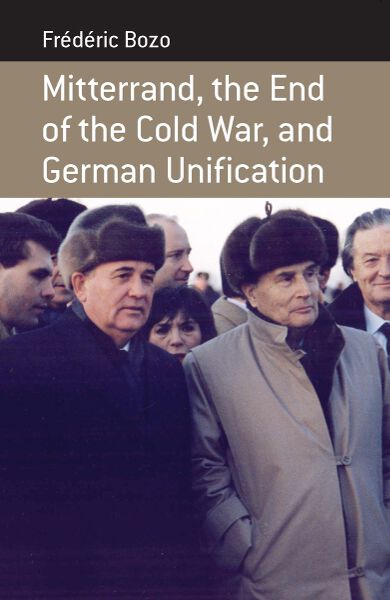Institute of French Studies Colloquium
FREDERIC BOZO
Historian, Université de Paris 3 - Sorbonne Nouvelle
 Mitterrand, the End of the Cold War, and German Unification
Mitterrand, the End of the Cold War, and German UnificationFrédéric Bozo is a Professor of European Studies at the Université de Paris III – Sorbonne. His research focuses on French foreign and security policy, transatlantic relations and Cold War history. His publications include: Mitterrand, the End of the Cold War, and German Unification (Berghahn Books); Two Strategies for Europe: De Gaulle, the United States and the Atlantic Alliance (2001). He also co-edited Europe and the End of the Cold War: A Reappraisal (2008) and published a book of interviews with Stanley Hoffmann, Gulliver Unbound: America’s Imperial Temptation and the War in Iraq (2004). His books in French include: La Politique étrangère de la France depuis 1945 (1997), and La France et l’OTAN. De la guerre froide au nouvel ordre européen (1991). During academic year 2010-2011, he is a Fulbright Scholar and serves as a Public Policy Scholar at the Woodrow Wilson Center in Washington, where he works on a book on the 2002-2003 transatlantic crisis over Iraq.
Presented with the support of the Cultural Services of the French Embassy.Thursday, December 2, 7:00 p.m.
Co-sponsored by La Maison Française, Casa Italiana, and Deutsches Haus
KENNETH E. SILVER
Professor of Modern Art, NYU; author of Esprit de Corps; An Expressionist in Paris; Making Paradise; guest curator, Chaos and Classicism, Guggenheim Museum
 Chaos and Classicism: Art in France, Italy, and Germany, 1918-1936
Chaos and Classicism: Art in France, Italy, and Germany, 1918-1936Guggenheim Museum exhibition on view through January 9, 2011
Discussants:
Molly Nolan
Professor of History, NYU
Ara H. Merjian
Assistant Professor of Italian Studies and Art History, NYU
Francine Goldenhar
Director, La Maison Française, NYU (moderator)
Following the chaos of World War I, a move emerged towards figuration, clean lines, and modeled form, and away from the two-dimensional abstracted spaces, fragmented compositions, and splintered bodies of the avant-gardes—particularly Cubism, Futurism, and Expressionism —that dominated the opening years of the 20th century. After the horrors visited upon humanity in the Western hemisphere by new machine-age warfare, a desire reasserted itself to represent the body whole and intact. For the next decade-and-a-half classicism, “return to order,” synthesis, organization, and enduring values, rather than the pre-War emphasis on innovation-at-all-costs, would dominate the discourse of contemporary art. Chaos and Classicism traces this interwar classical aesthetic as it worked its way from a poetic, mythic idea in the Parisian avant-garde; to a political, historical idea of a revived Roman Empire, under Mussolini; to a neo-Platonic High Modernism at the Bauhaus, and then, chillingly, a pseudo-biological classicism, or Aryanism, in nascent Nazi culture.
Chaos and Classicism: Art in France, Italy, and Germany, 1918–1936 is the first exhibition in the United States to focus upon this international phenomenon and to examine its manifestations in all media.
Through December 21
(Please check website for days the gallery will be closed for university events)
EXHIBITION
Henri Matisse: Writers on Paper
Selected Drawings and Prints from The Pierre and Tana Matisse Foundation
Curated by Martin Fisher and Martin Mullin.

The first exhibition devoted to Matisse's male portraiture. Many of these drawings and prints of writers who were friends and collaborators of the artist have never before been exhibited. It includes a selection of intimate drawings and prints of writers, including Matisse’s friends, colleagues, and a young poet and martyr, Roger Bernard, whom Matisse admired.
Central to Writers on Paper are seven large pen-and-ink portraits of Louis Aragon, one of France’s foremost poets, who became one of Matisse’s most passionate advocates. Other drawings and lithographs in this jewel-like exhibition portray Henri de Montherlant, Paul Léautaud, and Matisse’s mysterious neighbor, Franz Thomassin, an avant-garde writer who published under the name Franz Viller. The images in this exhibition offer insights into
the personalities of these writers. Indeed, Matisse’s spontaneous portraits are like frames from candid documentary films. Rendered in his hallmark stenographic style, the artist’s observations are imbued with clarity, elegance, and strong expressive power.
Portrait d'homme de profil (Roger Bernard), 1946 Charcoal © 2010 Succession H. Matisse / Artists Rights Society (ARS), New York
Organized by The Pierre and Tana Matisse Foundation together with Museum Projects Partnership, and received support from La Maison Francaise of NYU, Artists Rights Society.
Comments